Contents
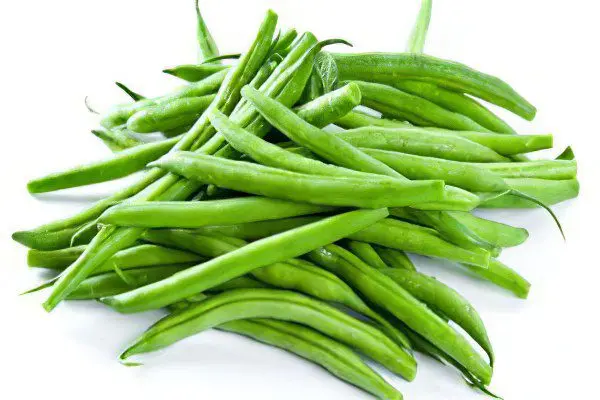
Many centuries ago, the ancient Egyptians, Chinese and South Americans discovered the value of such a food product as green beans. People have learned not only to eat it, but also to make a variety of medicinal and cosmetic products from it. In the sixteenth century, string beans were brought to Europe, but here its benefits to the human body were not appreciated. Beans began to be grown exclusively as an ornamental plant, people did not eat it, but admired the flowers and climbing shoots.
It wasn’t until the 18th century that Europeans began to eat beans. At first they ate the grains, and then the pods. After some time, new varieties of beans were cultivated, which had an improved taste, were more juicy and tender. In this way, string beans were obtained, which will later be called French.
At the moment, there are more than 20 varieties of beans that give beautiful flowers and are a valuable food product.
Useful properties of green beans
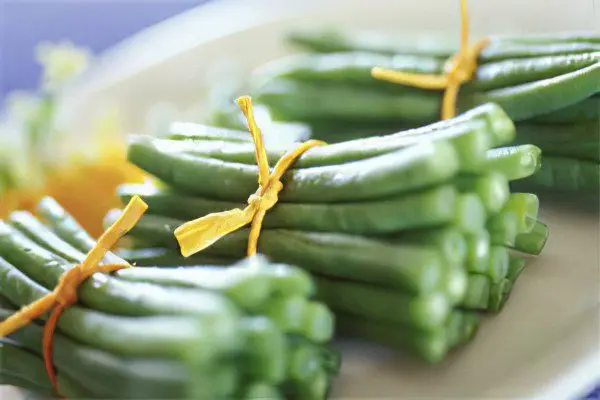
String beans, also called asparagus beans, are grown all over the world. It has found such wide distribution due to its amazing properties, because beans do not absorb toxins from the soil and from the external environment.
The product contains a large amount of vitamins and minerals, as well as amino acids, which are necessary to maintain health.
Green beans contain folic acid, which affects the hormonal background. Therefore, the product is useful for pregnant women, adolescents and women in the menopausal period.
String beans are rich in iron and molybdenum. These microelements are necessary for blood, for respiratory organs. They must be supplied with food to the body of people suffering from anemia.
Copper, which is part of green beans, can reduce the risk of developing arthritis and other joint diseases.
Thanks to the magnesium present in green beans, you can get rid of chronic fatigue, which is especially important for nervous exhaustion. Magnesium is useful for people with diabetes and overweight people.
Stabilization of carbohydrate metabolism in the body contributes to zinc, which is part of green beans.
There is a lot of sulfur in beans, which helps to get rid of intestinal diseases of an infectious nature.
Potassium has a beneficial effect on the work of the heart and blood vessels, which can also be obtained by regularly eating green beans.
The use of beans in food has a positive effect on the state of the immune system, helps to increase the body’s resistance to the effects of external negative factors.
Thanks to the fiber, which is part of the beans, the work of the digestive tract is normalized.
It has been proven that green beans are one of the healthiest foods for diabetics, as they help lower blood sugar levels.
Patients with hypertension, arrhythmia and atherosclerosis should definitely include beans in their menu.
If you replace bread and potatoes with beans, you can quickly lose weight.
Green beans are useful for men, as it is a means for the prevention of prostate adenoma. Regular consumption of green beans in food can improve potency, as well as get rid of kidney stones.
Beans are used in cosmetology. It is used in the creation of not only medical, but also decorative cosmetics. Regular inclusion of green beans in the menu allows you to slow down the aging process in the body and has a beneficial effect on the condition of the skin.
Beans contain fats, proteins, carbohydrates and vegetable fiber. Moreover, the protein from beans is similar to the protein from animal products. Of course, it is inferior to the protein that a person receives from meat, but in combination with other products it can replace it. This useful property of green beans is actively used by vegetarians and fasting people.
Nutritionists put green beans on the first place of the podium among other products for their beneficial qualities. They recommend that their patients consume green beans at least twice a week.
Harm and contraindications of green beans
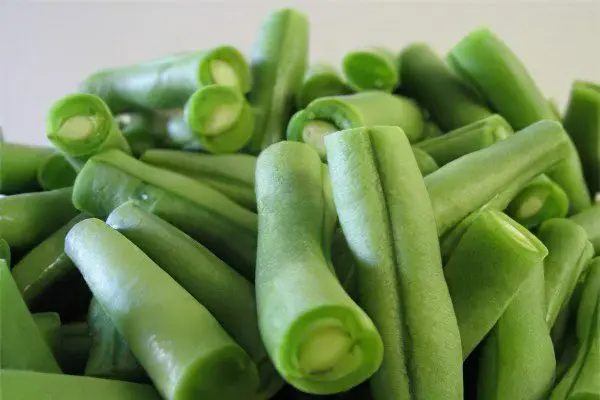
String beans, under certain conditions, can harm the human body.
Therefore, it is so important to know the contraindications to the use of the product:
Colitis.
Gastritis.
Peptic ulcer of the stomach and intestines.
Cholecystitis.
People with a history of gout and nephritis should eat beans with caution. Lean on dishes with beans should not be for the elderly, people with high acidity of gastric juice, as well as with a tendency to increased gas formation. Like other legumes, green beans can cause flatulence.
String beans can be harmful if the conditions for its preparation are not followed. So, it is strictly forbidden to eat a raw product. Pods and grains of beans contain toxic substances, one of which is phenazine. After entering the human body, it causes severe intoxication, and also has a destructive effect on the mucous membrane of the stomach and intestines.
Beans must be boiled before being eaten. Moreover, the cooking time should be at least 1,5 hours. Only in this way will it be possible to destroy the harmful substances that make up its composition, and this does not affect the benefits of the product.
Thus, it is possible and necessary to eat green beans, but on condition that there are no contraindications to this. Beans are a useful product that allows you to maintain youth and health for many years.
Caloric value

The average calorie content of 100 g of green beans is 18 kcal, although for a more accurate calculation of kilocalories, you will need to know the bean variety. The calorie content of raw green beans varies from 18 to 32 kcal per 100 g of product. However, it is not eaten raw, as it can provoke poisoning of the body.
The cooking process affects the final calorie content of the product, since during heat treatment, carbohydrates, fats and proteins are transformed. In addition, the calorie content of the final dish is influenced by the addition of seasonings, spices, butter, cream, etc.
Ready boiled green beans can have from 47 to 128 kcal per 100 g of product. It can be added to salads or eaten as a side dish.
Fried green beans are an even more high-calorie dish that is not entirely suitable for dietary nutrition. 100 g of fried beans contains 178 kcal.
If the beans are stewed, then its average calorie content per 100 g of the product will be 136 kcal. In fresh frozen green beans, no more than 28 kcal per 100 g.
The calorie content of all products, including beans, is determined by the amount of fat, backs and carbohydrates in them. So 1 g of fat is 9 kcal, 1 g of protein and carbohydrates is 4 kcal. Thus, the energy value of the product is calculated.
Nutritional value of string beans
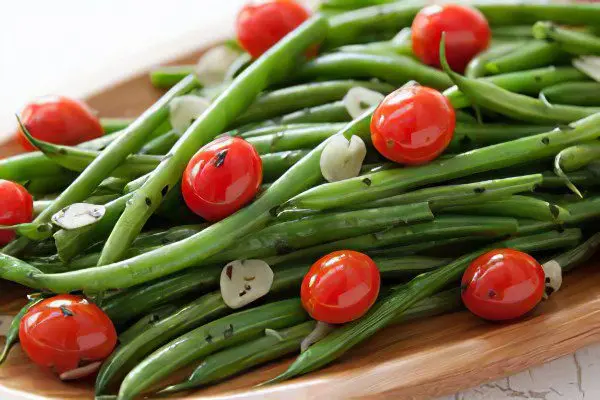
Product nutritional value:
Carbohydrates 3,14 g
Proteins 1,2 g.
Fat – 14 g.
Nutritional value – this is the set of useful properties of the product that provides the physiological needs of a person, therefore, in addition to fats, proteins and carbohydrates.
You can consider other components that make up the beans, including:
Water – 90 g.
Starch – 1
Organic acids – 0,1 g.
Dietary fiber – 3,4 g.
Saturated fatty acids – 0,1 g.
Ash – 0,7 g.
Green beans are rich in vitamins, including:
Vitamin A – 67 mcg.
Vitamin PP – 0,5 mg.
Vitamin B1 – 0,1 mg.
Vitamin B2 – 0,2 mg.
Vitamin B5 – 0,2 mg.
Vitamin B6 – 0,2 mg.
Folic acid – 36 mcg.
Vitamin C – 20 mg.
Vitamin E – 0,3 mg.
Niacin equivalent – 0,9 mg.
Beta-carotene – 0,4 mg.
There are many micro and macro elements in green beans:
Calcium – 65 mg.
Potassium – 260 mg.
Magnesium – 26 mg.
Iron – 1,1 mg.
Sodium – 2 mg.
Phosphorus – 4,4 mg.
Iodine – 0,7 mg.
Zinc – 0,18 mg.
Sera – 9 mg.
Copper – 33 mg
Fluorine – 2,5 mcg.
Selenium – 1,4 mcg.
Silicon – 5,25 mg.
Cobalt – 1 μg.
String beans have a fairly low glycemic index, which is equal to the number fifteen, that is, no more than 15% of carbohydrates are transformed into glucose. The product has a positive effect on metabolism, does not provoke a feeling of fatigue, and does not allow you to gain excess weight.
Varieties of string beans
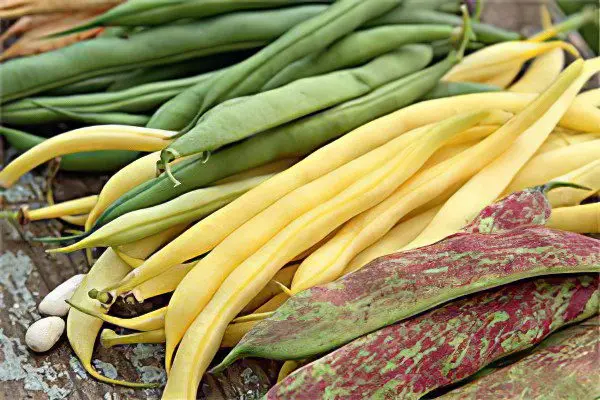
There are many varieties of beans, there are about 50 of them. There are beans that grow in bushes, there are climbing plants that look like grapes. So, the pods of Chinese and Japanese beans can reach a length of 90 cm.
In Russia, red and yellow string beans are more common, although there are also such plant varieties as:
Asparagus beans “Fana” from Poland. The plant has white seeds and green pods. This type of bean is very resistant to various diseases and has powerful antibacterial properties. Fana is great for canning.
Another bean variety from Poland is the Panther bean. The plant has juicy yellow pods. They can be eaten even fresh.
The bean variety “Deer King” comes from Holland. This variety gives a large yield, the pods have a rich yellow color. Beans have a mild flavor. Harvest of the Deer King can be harvested 2 times a year.
American “Royal Purple” beans produce pods that are reddish when grown. But after heat treatment, they turn green.
Another American bean variety is called “Indiana”. The pods of these beans contain grains that have a cherry pattern that resembles an Indian in a sombrero.
Beans “Blau Hilde” from Australia. This plant has purple pods and creamy grains.
The American blue bean is famous for its abundant harvest. Its pods are purple in color, and the grains reach large sizes.
Ad Ram is another American bean variety that also produces a bountiful harvest. The grains of this bean have a pleasant mushroom smell, which persists after heat treatment. The color of the grains is lilac-pink.
American fruit variety “Golden Nectar”. This bean is characterized by early germination, long pods can be harvested already 2 months after planting.
The Japanese Akito bean variety is distinguished by black grains that have a delicate mushroom smell. This is a very productive variety.
Ways to harvest green beans for the winter

In the store at any time of the year you can buy green beans, but often the price of the product is too high. Moreover, the conditions under which the product was grown remain unknown. For these reasons, many housewives prefer their own harvested beans.
In order to be able to use home-made green beans in winter, you need to take care of this even in the summer or autumn months.
Frost. String beans can be frozen. In this form, it retains all the beneficial properties and practically does not lose vitamins. Before freezing, the beans are washed, cut into pieces, placed in plastic bags or in containers, and then put into the freezer.
canning
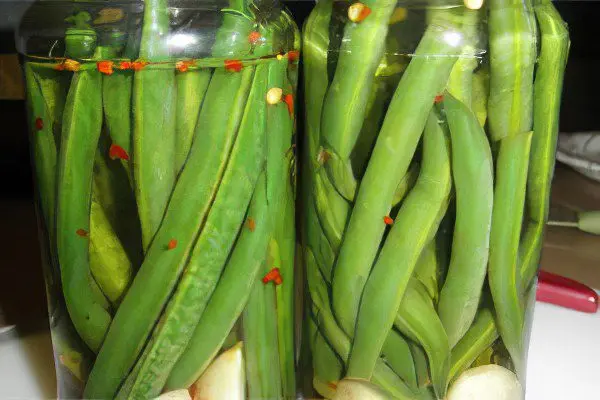
Canned salads with green beans are a good addition to meat dishes. Very tasty pickled beans. It is an excellent independent snack, can be used as a side dish. There are a huge number of salads in which one of the ingredients is just pickled green beans.
For blanks, you should take a fresh product. If the beans are a little dry, then they must be soaked in water before cooking.
Recipe №1. To prepare a liter of brine, which will be filled with beans, you will need 40 g of sugar and salt, cloves and peppercorns (to taste). Water must be taken taking into account the fact that some of it will be absorbed by the beans themselves, and some of it will evaporate.
Pour the beans with brine, bring to a boil and reduce the heat. Cook the beans until soft. The average cooking time is 1,5 hours. At the end of cooking, 70% vinegar is added to the brine (a teaspoon per liter of water). Without waiting for cooling, the beans are transferred to jars that have been previously sterilized. Then they are covered with a warm towel and left to cool.
Recipe №2. You can prepare a salad from beans for the winter by adding other vegetables to it, which will require:
Half a kilo of beans.
3 medium sized onions.
5 medium sized tomatoes.
Xnumx carrot.
Sunflower oil – 3 tablespoons.
2 teaspoons of sugar and salt.
40 ml table vinegar.
Ground pepper and peppercorns.
Medium bunch of basil.
All ingredients must be carefully. Coarsely chop the beans and basil, cut the carrots into cubes, and cut the onion into half rings. Before cutting tomatoes, you need to remove the skin from them. To do this, the tomatoes are preliminarily doused with boiling water, after which they are cut into slices.
Onions, carrots and tomatoes are stewed with oil for 10 minutes, after which all spices, beans and basil are added to them. Leave the salad on the fire for another 5 minutes, then pour in the vinegar and mix thoroughly. The last stage of preparation is to transfer the salad into jars and sterilize it for 5 minutes.
Recipe №3. This is another bean salad recipe with eggplant and tomatoes.
To prepare it, you will need the following ingredients:
String beans – 1 kg.
Two kilos of eggplant.
Fresh tomato juice – 2 liters.
Carrots and onions 0,5 kg each.
Vegetable oil – 0,5 liter.
Bell pepper.
Sugar – 70
Salt – 80
Apple cider vinegar – 100 ml.
Fresh parsley – half a bunch.
Before adding to the salad, beans will need to be boiled until fully cooked. Peppers are cut into strips, eggplant into cubes, and onions into half rings. Carrots are chopped on a grater. All vegetables are laid out in boiled tomato juice and boiled for an hour. At the end, you need to add apple cider vinegar, and then roll the salad into pre-sterilized jars.
Recipe №4. You can cook green beans in tomato sauce and roll them into jars for the winter:
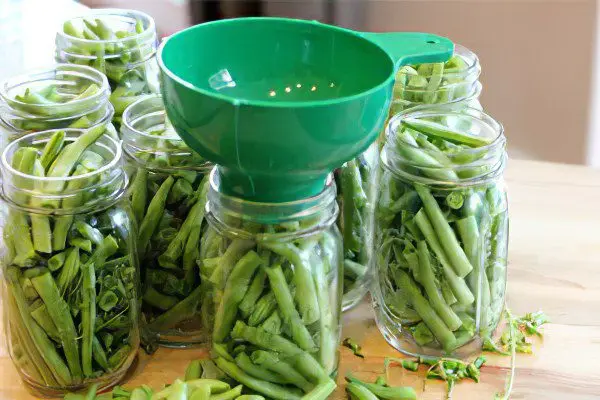
Beans need to be boiled until fully cooked in lightly salted water.
Drain beans in a colander to drain excess liquid. Then spread it over the banks.
Bring the tomato juice to a boil and pour over the beans.
Place the jars in a suitable container and sterilize for an hour.
You can add other vegetables to the beans, which will only improve the taste of the dish:
To prepare a vegetable mixture for 1 kg of beans, you need 800 g of tomatoes, 200 g of carrots and onions.
You also need to take 1 tbsp. a spoonful of sugar, 2 tbsp. tablespoons of salt, peppercorns, bay leaf, vinegar 9% – 2 tbsp. spoons, parsley.
The beans should be cut and steamed for about 5 minutes and then cooled.
Cut the onion and carrot and fry with the addition of vegetable oil.
Pass the tomatoes through a meat grinder, add sugar, salt and vinegar to them, then bring to a boil and boil for about 15 minutes.
Then all the ingredients are added to the tomato brine and boiled for another 30 minutes.
The resulting salad is laid out in jars that need to be sterilized in advance.









